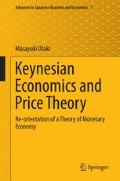Abstract
This chapter summarizes all five parts of this book. It aims to clarify the objectives of the book for the reader, and to show how cohesively the contents relate to each other. Readers will find that the basic theory of this book, which is ultimately represented by the fundamental equation outlined in Chap. 2, promises quite strong applications in the various fields of macroeconomic theory. This is because the fundamental equation is the critical concept that ties the monetary economy together in comparison to neoclassical microeconomic theory.
Access this chapter
Tax calculation will be finalised at checkout
Purchases are for personal use only
Notes
- 1.
They assume a Hoteling-type circle model. As the distance from an individual, which corresponds to the variation of goods, becomes large, the good produced at such a location brings less utility.
References
Arrow KJ (1962) The economic implications of learning by doing. Rev Econ Stud 29:155–173
Barro RJ, Grossman HI (1971) A general disequilibrium model of income and employment. Am Econ Rev 61:82–93
Blanchard OJ, Kiyotaki N (1987) Monopolistic competition an the effects of aggregate demand. Am Econ Rev 77:647–666
Calvo GA (1883) Staggered prices in a utility-maximizing framework. J Monetary Econ 12:383–398
Coase RH (1937) The nature of the firm. Economica 4:386–405
Diamond P (1982) Aggregate-demand management in search equilibrium. J Polit Econ 90:927–954.
Fleming JM (1962) Domestic fiscal policies and floating exchange rates. IMF Staff Pap 9:369–380
Gali G (2008) Monetary policy, inflation, and the business cycle: an introduction to the new Keynesian framework. Princeton University Press, Princeton
Kahn RF (1931) The relation of home investment to unemployment. Econ J 41:173–198
Keynes JM (1936) The general theory of employment, interest and money. Macmillan, London
Kiyotaki N, Wright R (1989) On money as a medium of exchange. J Polit Econ 97:927–954
Kiyotaki N, Wright R (1991) A contribution to the pure theory of money. J Econ Theory 23:215–235
Laursen S, Metzler L (1950) Flexible exchange rates and the theory of employment Rev Econ Stat:281–299
Lucas RE Jr (1972) Expectations and the neutrality of money. J Econ Theory 4:103–124
Mundell RA (1961) A theory of optimum currency area. Am Econ Rev 51:657–665
Mundell RA (1963) Capital mobility and stabilization policy under fixed and flexible exchange rates. Can J Econ Polit Sci 29:475–485
Obstfeld M, Rogoff K (1996) Foundations of international economics. MIT Press, Massachusetts
Otaki M (2007) The dynamically extended Keynesian cross and the welfare-improving fiscal policy. Econ Lett 96:23–29
Otaki M (2009) A welfare economic foundation for the full-employment policy. Econ Lett 102:1–3
Otaki M (2011a) A pure theory of aggregate price determination. Theor Econ Lett 1:122–128
Otaki M (2011b) Kahei koyo riron no kiso (Fundamentals of the theory of money and employment). Keiso Shobo, Tokyo
Otaki M (2012a) A Keynesian model of a small open economy under a flexible exchange rate. Theor Econ Lett 2:278–282
Otaki M (2012b) The role of money: credible asset or nemeraire. Theor Econ Lett 2: 365–368
Otaki M (2012c) A microeconomic foundation for optimum currency area. Theor Econ Lett 2:395–399
Otaki M (2013a) How a key currency functions as an international liquidity provision and insurance system. Theor Econ Lett 3:43–47
Otaki M (2013b) Evaluation of dexterity and a theory the growth of a firm. Mod Econ 4:226–229
Otaki M (2013c) On the endogenous sustainability of economic growth: why is the scale of government enlarged? Theor Econ Lett 3:159–163
Otaki M (2013d) Kokuai Kinyu Keizai seicho riron no kiso (Fundamentals of the theory of international economics and economic growth). Keiso Shobo, Tokyo
Otaki M (2014a) Income disparity, uneven economic opportunity, and verifiability. Adv Soc Sci Res J 1:44–49
Otaki M (2014b) Efficacy in education and intergenerational wellbeing. Theor Econ Lett 4:183–189
Otaki M, Tamai Y (2011) On the dynamic role of monopolistic competition. Theor Econ Lett 1:114–117
Otaki M, Tamura M (2013) Monetary growth theory under perfect and monopolistic competitions. Theor Econ Lett 3:216–219
Otaki M, Yaginuma H (2012) Kigyo seicho to jinteki shihon no chikuseki: keieiken to kigyo seicho no conflict (The growth of a firm and accumulation of human capital: the conflict between the managerial right and the growth of a Firm). DBJ Discussion Paper Series No. 1208, Research Institute of Capital Formation, Development Bank of Japan. http://www.dbj.jp/ricf/research/discussion.html. Accessed 22 July 2014
Otani K (1985) Rational Expectations and non-neutrality of money. WeltwirtschaftlichesArch 121:207–216
Penrose E (1959) The theory of the growth of the firm. Oxford University Press, Oxford
Tobin J (1969) A general equilibrium approach to monetary theory. J Money Credit Bank 1:15–29
Uzawa H (1969) Time preference and Penrose effect in a two-class model of economic growth. J Polit Econ 77:628–652
Author information
Authors and Affiliations
Corresponding author
Rights and permissions
Copyright information
© 2015 Springer Japan
About this chapter
Cite this chapter
Otaki, M. (2015). Introduction. In: Keynesian Economics and Price Theory. Advances in Japanese Business and Economics, vol 7. Springer, Tokyo. https://doi.org/10.1007/978-4-431-55345-8_1
Download citation
DOI: https://doi.org/10.1007/978-4-431-55345-8_1
Published:
Publisher Name: Springer, Tokyo
Print ISBN: 978-4-431-55344-1
Online ISBN: 978-4-431-55345-8
eBook Packages: Business and EconomicsEconomics and Finance (R0)

